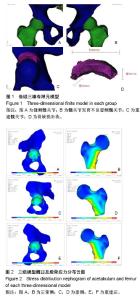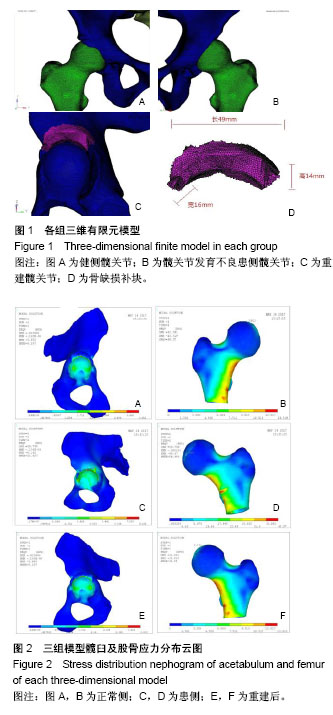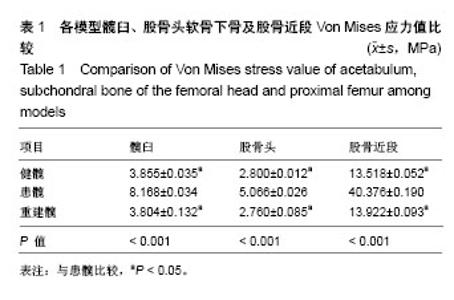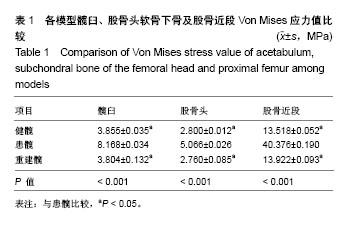| [1] 石学锋,布金鹏,李金松.成人髋臼发育不良生物力学改变及治疗现状[J].中国矫形外科杂志,2003,11(17):1202-1203.[2] Banaszkiewicz PA. Total hip replacement in congenital dislocation and dysplasia of the hip. Classic Papers in Orthopaedics. Springer London, 2014:15-23. [3] 郭磊,赵玉岩,范广宇,等.髋臼发育不良的生物力学实验研究[J].中国医科大学学报,2001,30(4):277-278.[4] 傅明,张志奇,向珊珊,等.髋臼旋转截骨术及Chiari截骨术对发育性髋关节发育不良生物力学影响的比较研究[J].中国修复重建外科杂志,2013,27(6):641-644.[5] 向珊珊,陈艺,傅明,等.髋臼旋转截骨术时髋臼后上方植骨前后髋关节生物力学的改变及其对比[J].中华关节外科杂志(电子版), 2012,6(3):68-71.[6] Lubovsky O, Peleg E, Joskowicz L, et al. Acetabular orientation variability and symmetry based on CT scans of adults. Int J Comput Assist Radiol Surg. 2010;5(5):449. [7] 邱国良,邱轩,张长青,等.改良Chiari截骨髋臼加盖延伸成形术治疗发育性髋关节脱位远期生物力学分析[J].中国矫形外科杂志, 2015,23(3):276-283.[8] 陈晓东,林建华.髋臼翻转造盖术治疗成人髋臼发育不良的生物力学研究[J].中国骨与关节损伤杂志,2006,21(3):176-178.[9] 牟世祥,王春祯,王禹增,等.带缝匠肌蒂髂骨移植髋臼成形术治疗发育性髋关节发育不良[J].中国骨与关节损伤杂志, 2006,21(1): 49-50.[10] 王琦,张先龙,蒋垚,等.髋关节表面置换术治疗CroweⅠ、Ⅱ型髋关节发育不良[J].中华解剖与临床杂志,2014,19(1):19-23.[11] 赵振刚,刘建国,齐欣.成人髋臼发育不良的治疗研究进展[J].中国骨与关节损伤杂志,2007,22(1):83-85.[12] 田丰德,赵德伟,李东怡,等.髋臼缺损程度对成人髋关节应力影响的三维有限元分析[J].中国组织工程研究,2018,22(3):380-384.[13] 许杰,马若凡,李登,等.髋臼发育不良髋关节置换前髋臼侧的三维测量[J].中国组织工程研究,2013,17(43):7507-7513.[14] Clavé A, Tristan L, Desseaux A, et al. Influence of experience on intra- and inter-observer reproducibility of the Crowe, Hartofilakidis and modified Cochin classifications. Orthop Traumatol Surg Res Otsr. 2016;102(2):155-159. [15] 肖瑜,张福江,马信龙,等.成人髋关节发育不良不同Crowe分型的三维CT影像学特征[J].中华骨科杂志,2014,34(3):311-316.[16] Tian FD, Zhao DW, Wang W, et al. Prevalence of developmental dysplasia of the hip in chinese adults: a cross-sectional survey. Chin Med J. 2017;130(11):1261-1268. [17] 冉学军,蒲川成,胡兆洋,等.Crowe Ⅲ、Ⅳ型成人髋臼发育不良THA术中髋臼重建体会[J].中国骨与关节损伤杂志, 2018, 23(2):159-160.[18] 周金,刘炯,杨砥,等.3D打印技术辅助成人DDH初次THA的髋臼置入[J].中国矫形外科杂志,2017,25(23):2182-2186.[19] 朱贤平,滕晓,泮宸帅,等.旋转中心内移结合上移重建髋臼技术治疗Crowe Ⅱ、Ⅲ型成人发育性髋关节发育不良的疗效分析[J].中华危重症医学杂志(电子版),2017,10(1):34-39.[20] 周杰,熊小明,刘昕,等.DDH股骨近端截骨儿童髋部锁定板与普通锁定板固定的比较[J].中国矫形外科杂志, 2017,25(23): 2128-2133.[21] 李文广,向浩,邹刚,等.伯尔尼髋臼周围截骨术治疗髋关节发育不良的近期疗效[J].临床骨科杂志,2017,20(4):432-436.[22] 何金鹏,郝运,郑强,等.CT三维重建评价发育性髋关节发育不良髋关节骨化发育研究[J].中华实验外科杂志, 2017,34(2): 325-328.[23] 路玉峰,许鹏,郭万首,等.成人正常髋关节旋转中心的X线影像测量研究[J].中华解剖与临床杂志,2017,22(2):99-102.[24] 颜俏燕,丁士申,刘铁军.X线正位片及多层螺旋CT三维成像检查在成人发育性髋关节发育不良中的诊断价值[J].广西医学, 2018, 40(4):451-453.[25] 杨溢,刘坚林,唐雷,等.采用数字人模型探究DDH闭合复位后股骨头缺血坏死的发生机制[J].中国矫形外科杂志, 2017,25(19): 1805-1810.[26] 李安安,刘谦,龚辉,等.“虚拟中国人男性一号”高精度骨骼系统的三维建模[J].中国临床解剖学杂志,2006,24(3):292-294.[27] 肖进,尹庆水,张美超,等.Mimics软件重建脊柱三维骨骼数据基础上快速成型的脊柱畸形模型[J].中国组织工程研究, 2008, 12(35): 6835-6838.[28] 李伟,张宏,曹丽君,等.脊柱腰段正常及骨质疏松三维有限元数字模型的建立[J].中国组织工程研究,2013,17(9):1521-1526.[29] 王百盛,张敬东,韩文锋,等.3-D打印技术辅助人工全髋关节置换术治疗Crowe Ⅳ型髋关节发育不良合并股骨近段畸形一例[J].中国修复重建外科杂志,2018,32(1):125-127.[30] 涂强,曹露,丁焕文,等.3D打印个性化手术导航模板在成人发育性髋脱位髋臼重建中的应用[J].临床外科杂志, 2017,25(4): 295-299.[31] Brekelmans WAM, Rybicki EF, Burdeaux BD. A new method analysys mechanical behavior of skeletal parts. Acta Orthop Scand. 1972;43:301-305. [32] 崔旭,赵德伟,古长江.股骨头缺血性坏死塌陷预测的生物力学研究[J].中国临床解剖学杂志,2005,23(2):82-87.[33] 吴天顺,陈扬,蓝涛,等.脊柱3D打印椎间融合器材料的初步展望[J].生物骨科材料与临床研究,2018,15(1):58-63.[34] 刘忠军.金属3D打印骨科内植物的应用现状与发展趋势浅析[J].骨科临床与研究杂志,2017,2(2):65-67.[35] 王燎,戴尅戎.骨科个体化治疗与3D打印技术[J].医用生物力学, 2014,29(3):193-199.[36] 蒋明辉,蔡立宏,雷青,等.3D打印技术在骨科临床的应用研究及展望[J].中华损伤与修复杂志:电子版,2016,11(4):288-290.[37] 宋哲,衡立松,王晨,等.3d打印模型在创伤骨科患者中的应用价值.美中国际创伤杂志,2017,16(3):4-7.[38] 范立军,李伟,范显超,等.3d打印实体模型在创伤骨科困难手术中的应用.中国伤残医学,2017,25(12):66-68.[39] 胡堃,李路海,余均武,等.3d打印技术在骨科个性化治疗中的应用.高分子通报,2015,28(9):61-70.[40] 熊敏剑,唐理英,莫世奋,等.3d打印骨折模型在股骨转子间骨折治疗中的应用价值.中国医药科学,2018,8(12):10-13.[41] 黄昆,唐箫,张淼.Mimics结合3d打印技术在骨科手术前演练体会[J].中国伤残医学,2018,26(10):58-59.[42] 时景伟,郑长军,李晓燕,等.3d打印技术在股骨头坏死治疗中的应用[J].中华实验外科杂志,2017,34(6):1076-1078.[43] 杨宇,刘大鹏,程奎,等.应用3d打印截骨导航模板进行胫骨截骨矫形的实验研究[J].中国数字医学,2017,12(1):58-60. |



